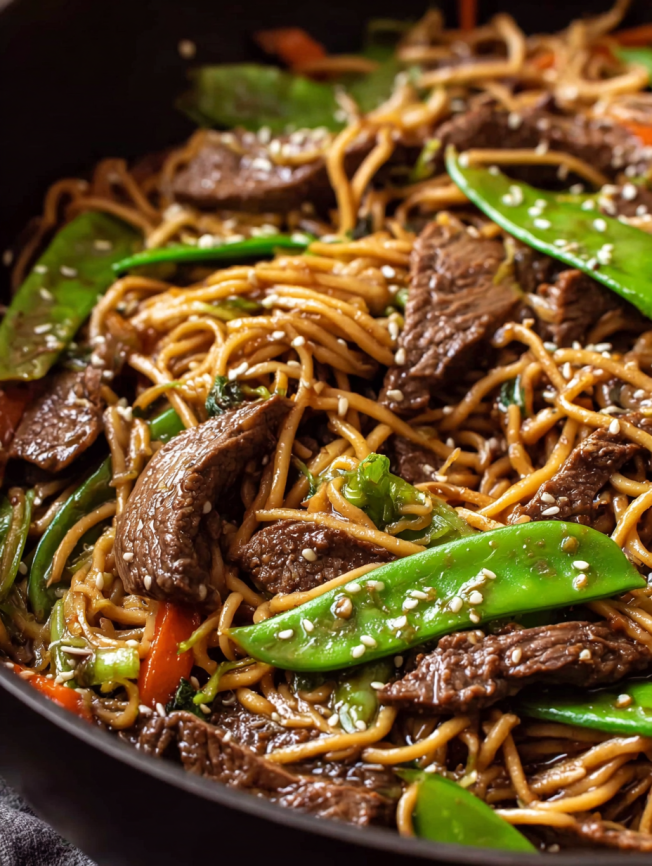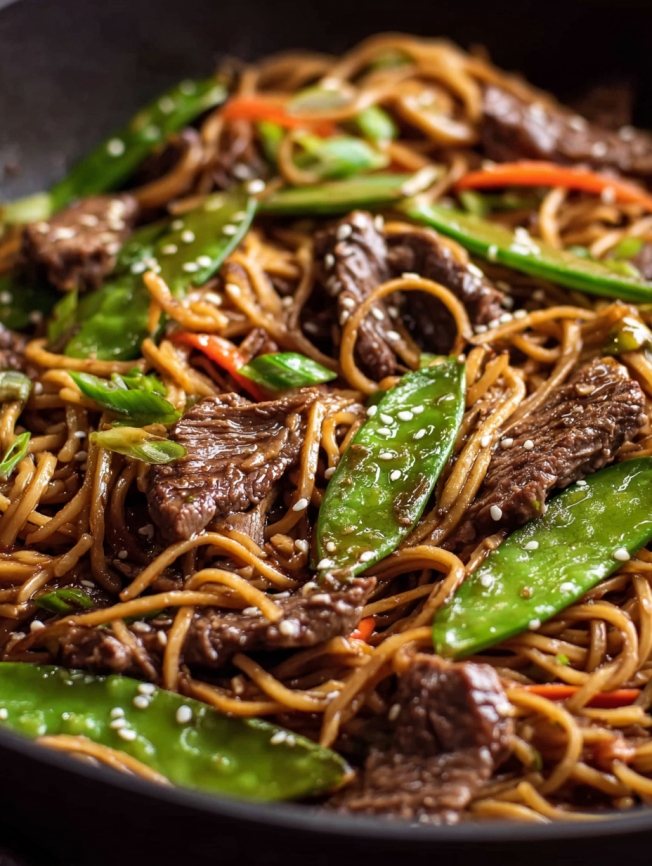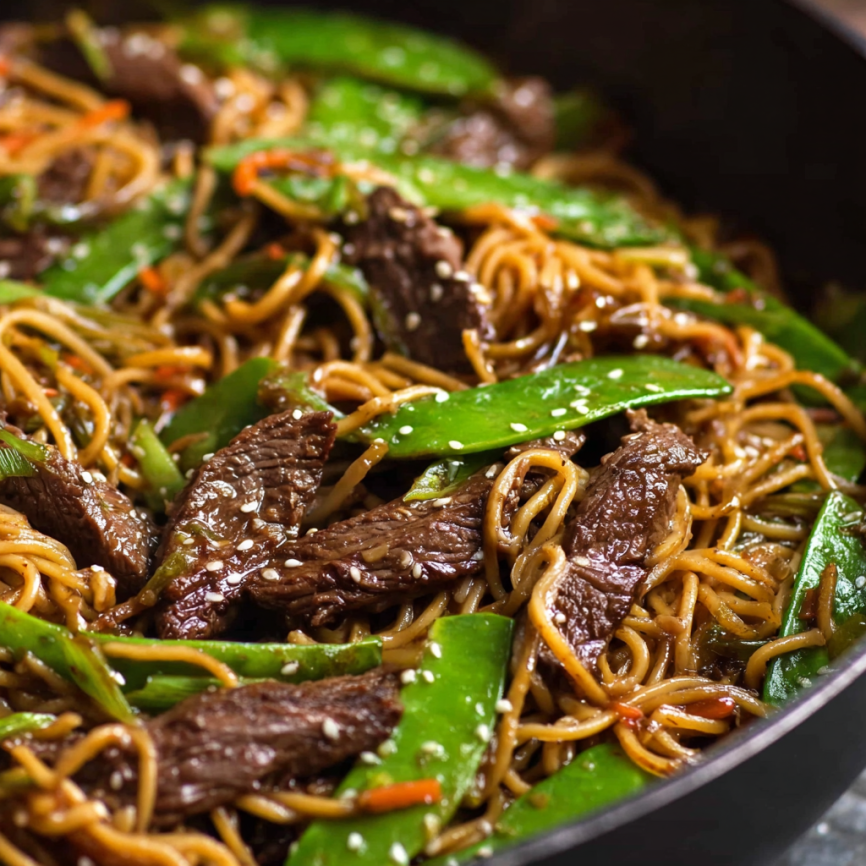Prep Time: 15 minutes
Cook Time: 12 minutes
Total Time: 27 minutes
Servings: 4 servings
Some evenings call for something extraordinary without the fuss of complicated cooking. This sesame beef stir fry became my go-to solution when I needed to impress my family on busy weeknights. The first time I made this dish, the combination of tender beef, crisp vegetables, and that incredible sesame-ginger sauce had everyone asking for seconds before they’d even finished their first helping.
Why This Recipe Will Transform Your Weeknight Dinners
Lightning-Fast Preparation
In less than 30 minutes, you’ll have a restaurant-quality meal on the table. The key lies in the efficient marinating process and high-heat cooking technique that locks in flavors while maintaining perfect textures.
Perfectly Balanced Flavors
The marinade creates layers of umami richness, while the sauce brings together sweet, salty, and slightly spicy elements. Each bite delivers a harmonious blend that satisfies without overwhelming your palate.
Customizable and Nutritious
This versatile recipe adapts easily to whatever vegetables you have on hand. Additionally, the lean protein and colorful vegetables provide a well-rounded, nutritious meal that doesn’t sacrifice flavor for health.
Essential Ingredients
For the Beef Marinade:
- 2 tsp garlic, minced
- 1 Tbsp fresh ginger, grated
- 2 Tbsp reduced sodium soy sauce
- 1 Tbsp rice vinegar
- 1 Tbsp sesame oil
- 1 Tbsp sesame seeds
- 1/2 tsp Chinese 5 spice
- 1/4 tsp black pepper
For the Stir Fry:
- 1 lb flank steak, thinly sliced
- 1 cup snow peas, sliced in half across
- 1/2 cup carrots, sliced
- 8 green onions, sliced
- 2 Tbsp vegetable oil (for cooking)
For the Sauce:
- 1/4 cup beef broth
- 2 Tbsp reduced sodium soy sauce
- 1-2 Tbsp honey or light brown sugar
- 1 Tbsp rice vinegar
- 1/2 Tbsp garlic, minced
- 2 tsp sesame oil
- 1 tsp fresh ginger, grated
- 1 tsp cornstarch
- 1/2 tsp red pepper flakes
Step-by-Step Instructions
Preparing the Beef Marinade
Start by combining all marinade ingredients in a medium bowl, whisking them together until well blended. Add the thinly sliced flank steak to this aromatic mixture, ensuring each piece is thoroughly coated. Set aside for 15 minutes to allow the flavors to penetrate the meat – this brief marinating time is crucial for tender, flavorful results.
Cooking the Beef
Heat 1 tablespoon of vegetable oil in a large skillet over medium-high heat until it shimmers. Remove excess marinade from the steak (don’t discard it completely), then add the beef to the pan in a single layer. Cook for 2-3 minutes, stirring occasionally to ensure both sides develop a beautiful sear. Depending on your pan size, you may need to work in batches to avoid overcrowding. Transfer the cooked beef to a plate and set aside.
Stir-Frying the Vegetables
Add the remaining tablespoon of oil to the same skillet, allowing it to heat briefly. Next, add the snow peas, carrots, and green onions to the pan. Stir-fry for 2-3 minutes, keeping the vegetables moving constantly to ensure even cooking while maintaining their crisp texture and vibrant colors.
Creating the Sauce
While the vegetables cook, whisk together the beef broth, soy sauce, honey (or brown sugar), rice vinegar, garlic, sesame oil, fresh ginger, cornstarch, and red pepper flakes in a small bowl. This sauce will be the flavor foundation that brings everything together.
Final Assembly
Return the cooked beef to the skillet with the vegetables, then pour the sauce mixture over everything. Stir continuously to combine all ingredients evenly. The cornstarch in the sauce will quickly thicken, creating a glossy coating that clings beautifully to both the beef and vegetables.

Serving Suggestions
Classic Presentation
Serve your sesame beef stir fry over steamed jasmine rice or brown rice for a traditional, satisfying meal. The rice absorbs the delicious sauce while providing a neutral base that lets the stir fry flavors shine.
Noodle Variations
For a more substantial dish, toss in cooked ramen noodles, rice noodles, or even spaghetti during the final step. The noodles will absorb the sauce and create a more filling, one-pan meal that’s perfect for hungry families.
Low-Carb Options
Serve over cauliflower rice or shirataki noodles for a lighter version that doesn’t compromise on flavor. You can also increase the vegetable content by adding bell peppers, broccoli, or snap peas.
Recipe Variations
Spice Level Adjustments
Increase the red pepper flakes to 1 teaspoon for more heat, or add a sliced jalapeño with the vegetables for fresh spice. Conversely, omit the red pepper flakes entirely for a milder version that’s kid-friendly.
Protein Alternatives
This recipe works beautifully with chicken breast, pork tenderloin, or even firm tofu. Simply adjust the cooking time accordingly – chicken and pork need slightly longer cooking, while tofu requires gentler handling.
Vegetable Substitutions
Use whatever vegetables you have available! Bell peppers, broccoli, mushrooms, baby corn, or water chestnuts all work wonderfully. The key is maintaining similar cooking times and textures.
Make-Ahead Tips
Meal Prep Strategy
Prepare the marinade and slice the beef up to 24 hours in advance. Store the marinated beef in the refrigerator, covered, until ready to cook. Additionally, you can pre-cut all vegetables and store them in airtight containers.
Sauce Preparation
The sauce can be whisked together and refrigerated for up to 3 days. Just give it a good stir before using, as the cornstarch may settle.
Freezing Options
While this dish is best enjoyed fresh, you can freeze the marinated raw beef for up to 3 months. Thaw completely before cooking, and note that the texture may be slightly different from fresh.
Professional Tips for Success
Achieving Perfect Beef Texture
The secret to incredibly tender beef lies in slicing technique. Cut the flank steak against the grain when it’s still partially frozen – this makes getting paper-thin slices much easier and results in more tender bites.
High-Heat Cooking
Don’t overcrowd the pan, as this will cause the beef to steam rather than sear. Working in batches ensures proper browning and prevents the meat from becoming tough.
Timing is Everything
Have all your ingredients prepped and ready before you start cooking. Stir-frying happens quickly, and you won’t have time to chop vegetables once the cooking begins.
Notes
Essential Slicing Tip: The game-changing technique for this recipe is slicing the flank steak while it’s still partially frozen. This method allows you to achieve incredibly thin, uniform slices with minimal effort, resulting in more tender beef that cooks evenly.
Marinade Timing: While 15 minutes is the minimum marinating time, you can marinate the beef for up to 24 hours for even more flavor penetration. However, don’t exceed this time, as the acid in the marinade can begin to break down the meat’s texture.
Heat Control: Maintaining medium-high heat throughout the cooking process is crucial. Too low, and you’ll miss out on the characteristic “wok hei” (breath of the wok) flavor that makes stir-fries so appealing.

Frequently Asked Questions
Q: Can I use a different cut of beef? A: While flank steak is ideal due to its grain structure and flavor, you can substitute with sirloin, skirt steak, or even ribeye. Just ensure you slice against the grain for maximum tenderness.
Q: My sauce didn’t thicken properly. What went wrong? A: This usually happens when the cornstarch isn’t properly dissolved or the heat is too low. Make sure to whisk the sauce thoroughly before adding it to the pan, and ensure your pan is hot enough for the cornstarch to activate.
Q: Can I make this gluten-free? A: Absolutely! Use tamari instead of soy sauce, and ensure your Chinese 5 spice blend is gluten-free. Check that your rice vinegar is also gluten-free, as some brands may contain gluten.
Q: How do I prevent the vegetables from becoming mushy? A: The key is high heat and constant movement. Don’t overcook the vegetables – they should retain some crispness for the best texture and nutritional value.
Q: Can I double this recipe? A: Yes, but you’ll need to work in smaller batches to avoid overcrowding. Use two pans simultaneously if possible, or cook in multiple batches using the same pan.
Q: What’s the best way to store leftovers? A: Store in the refrigerator for up to 3 days in an airtight container. Reheat gently in a skillet over medium heat, adding a splash of broth if needed to loosen the sauce.
Nutrition Information (per serving):
- Calories: 338kcal
- Carbohydrates: 13g
- Protein: 28g
- Fat: 19g
- Saturated Fat: 4g
- Cholesterol: 68mg
- Sodium: 713mg
- Fiber: 2g
- Sugar: 7g
This sesame beef stir fry proves that exceptional flavor doesn’t require hours in the kitchen. With its perfect balance of textures and tastes, it’s destined to become a regular feature in your weeknight dinner rotation.

